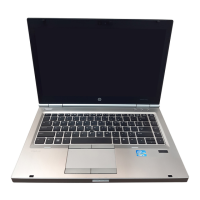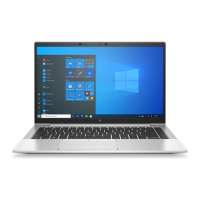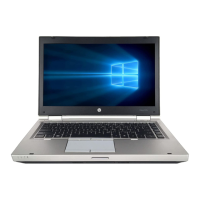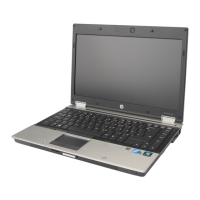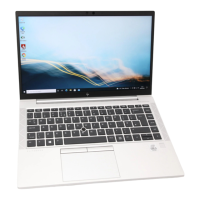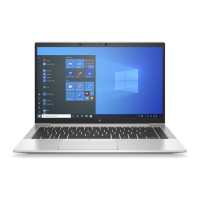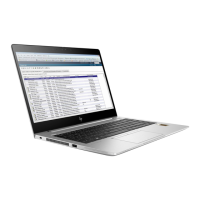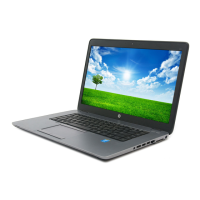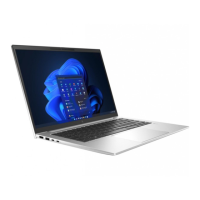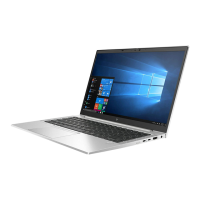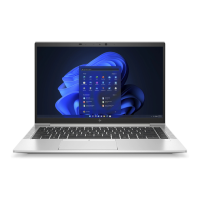Do you have a question about the HP EliteBook 8470w and is the answer not in the manual?
Identifies components on the display, keyboard, touchpad, and buttons.
Details components on the front, sides, rear, and bottom of the computer.
Explains the service tag and lists major internal computer components with part numbers.
Provides part numbers for display subcomponents, cables, storage, plastics, and miscellaneous items.
Outlines essential tools, service considerations, and handling precautions.
Covers ESD, packaging, workstation, and general equipment safety guidelines.
Detailed instructions for removing and replacing various computer components.
Guides on starting, using, and restoring settings in Computer Setup.
Instructions for checking and downloading BIOS updates.
Details on running diagnostic tests for computer hardware.
Provides detailed technical specifications for the computer, display, and hard drives.
Steps to restore the computer to its original factory state using recovery media.
Guidance on backing up important user files using the Backup Manager.
Specifies universal requirements for power cord length, capacity, and connector type.
Details specific power cord certifications and types required for various regions.
Identifies components on the display, keyboard, touchpad, and buttons.
Details components on the front, sides, rear, and bottom of the computer.
Explains the service tag and lists major internal computer components with part numbers.
Provides part numbers for display subcomponents, cables, storage, plastics, and miscellaneous items.
Outlines essential tools, service considerations, and handling precautions.
Covers ESD, packaging, workstation, and general equipment safety guidelines.
Detailed instructions for removing and replacing various computer components.
Guides on starting, using, and restoring settings in Computer Setup.
Instructions for checking and downloading BIOS updates.
Details on running diagnostic tests for computer hardware.
Provides detailed technical specifications for the computer, display, and hard drives.
Steps to restore the computer to its original factory state using recovery media.
Guidance on backing up important user files using the Backup Manager.
Specifies universal requirements for power cord length, capacity, and connector type.
Details specific power cord certifications and types required for various regions.
| Bus type | DMI |
|---|---|
| Stepping | E1 |
| Tjunction | 105 °C |
| Processor cache | 6 MB |
| Processor cores | 4 |
| Processor model | i7-3630QM |
| System bus rate | 5 GT/s |
| Processor family | Intel® Core™ i7 |
| Processor series | Intel Core i7-3600 Mobile series |
| Processor socket | PGA988 |
| Processor threads | 8 |
| Processor codename | Ivy Bridge |
| Processor frequency | 2.4 GHz |
| Processor cache type | Smart Cache |
| Processor lithography | 22 nm |
| Processor manufacturer | Intel |
| Processor front side bus | - MHz |
| PCI Express slots version | 3.0 |
| Processor boost frequency | 3.4 GHz |
| Processor operating modes | 64-bit |
| ECC supported by processor | No |
| PCI Express configurations | 1x16, 2x8, 1x8+2x4 |
| Thermal Design Power (TDP) | 45 W |
| CPU multiplier (bus/core ratio) | 24 |
| Maximum number of PCI Express lanes | 16 |
| Motherboard chipset | Intel® QM77 Express |
| Memory slots | 2x SO-DIMM |
| Internal memory | 8 GB |
| Memory clock speed | 1600 MHz |
| Memory form factor | SO-DIMM |
| Internal memory type | DDR3-SDRAM |
| Maximum internal memory | - GB |
| SSD capacity | The Solid State Drive's storage capacity in Gigabytes. |
| SSD interface | SATA |
| Storage media | SSD |
| Card reader integrated | Yes |
| Total storage capacity | 128 GB |
| Compatible memory cards | SD |
| Number of SSDs installed | 1 |
| Display diagonal | 14 \ |
| Display resolution | 1600 x 900 pixels |
| Native aspect ratio | 16:9 |
| On-board graphics card ID | 0x166 |
| Discrete graphics card model | AMD FirePro M2000 |
| On-board graphics card model | Intel® HD Graphics 4000 |
| Discrete graphics memory type | GDDR5 |
| On-board graphics card family | Intel® HD Graphics |
| On-board graphics card base frequency | 650 MHz |
| On-board graphics card dynamic frequency (max) | 1150 MHz |
| Intel segment tagging | Enterprise |
| Audio system | SRS Premium Sound PRO |
| Number of built-in speakers | 2 |
| Wi-Fi standards | 802.11a, 802.11b, 802.11g |
| Charging port type | DC-in jack |
| Headphone connectivity | 3.5 mm |
| USB 2.0 ports quantity | USB 2.0 ports have a data transmission speed of 480 Mbps, and are backwards compatible with USB 1.1 ports. You can connect all kinds of peripheral devices to them. |
| eSATA/USB 3.2 Gen 1 (3.1 Gen 1) ports quantity | 0 |
| Keyboard layout | - |
| Pointing device | Touchpad |
| Bundled software | Microsoft Office Starter (Windows 7)\\r HP Recovery Manager\\r HP Performance Advisor\\r HP Support Assistant\\r HP ProtectTools Security Manager\\r HP ProtectTools for Central Management\\r HP Hotkey Support\\r HP Peak Power Manager\\r HP Power Assistant (Windows 7)\\r HP Wireless Hotspot (Windows 8)\\r HP Connection Manager (Windows 7)\\r Adobe Flash Player (Windows 7)\\r Windows Defender\\r Microsoft Security Essentials (Windows 7)\\r PDF Complete Special Edition\\r Roxio Secure Burn (Windows 7)\\r Roxio MyDVD Business 2010 (Windows 7)\\r Winzip Basic (Windows 7)\\r HP SoftPaq Download Manager |
| Recovery operating system | Windows 7 Professional |
| Operating system installed | Windows 8 Pro |
| Form factor | Clamshell |
| Product type | Laptop |
| Product color | Gray |
| Country of origin | China |
| Processor code | SR0UX |
| Processor ARK ID | 71459 |
| Processor package size | 37.5 x 37.5 (rPGA988B) mm |
| Supported instruction sets | AVX |
| Intel Identity Protection Technology version | 1.00 |
| Battery capacity | 100 Wh |
| Battery life (max) | 5.45 h |
| Number of battery cells | 9 |
| AC adapter power | 90 W |
| Cable lock slot type | Kensington |
| Depth | 231.3 mm |
|---|---|
| Width | 338 mm |
| Height | 31.8 mm |
| Weight | 2250 g |
